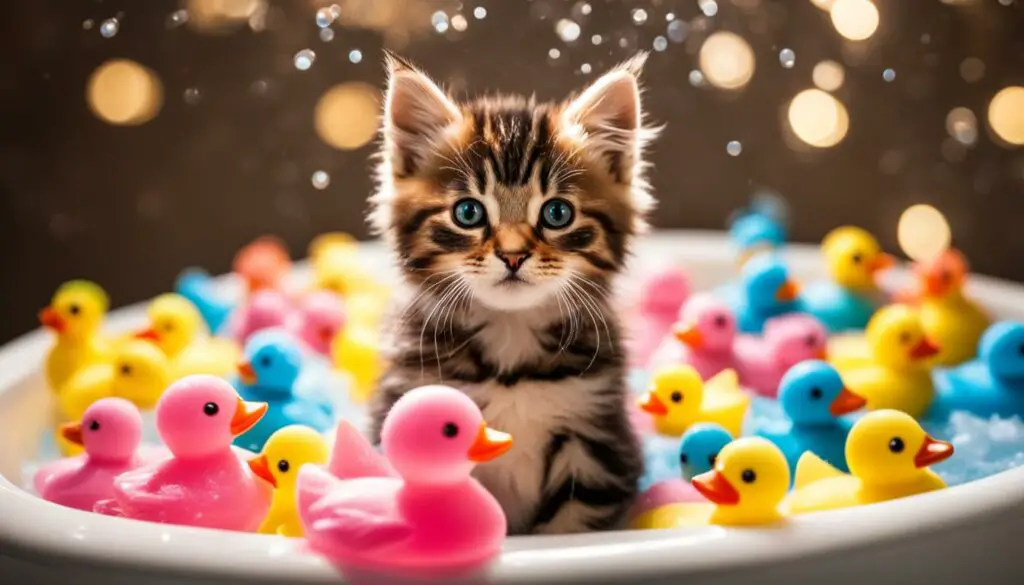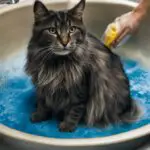Bathing cats is not as difficult as it seems. With the right techniques and preparations, you can make bath time safe and stress-free for your kitten. Cats only need to be bathed when they come into contact with substances they can’t safely lick off on their own. Longhaired cats benefit from routine bathing to degrease their coat and prevent matting. In this article, I will guide you step-by-step on how to bathe kittens effectively and provide essential tips for a successful bathing experience.
Key Takeaways:
- Proper bathing techniques can make bath time safe and stress-free for kittens.
- Cats only need to be bathed when they come into contact with substances they can’t lick off.
- Longhaired cats benefit from routine bathing to prevent matting.
- Prepare the bathing location and gather necessary equipment before bathing your kitten.
- Trim the kitten’s nails and brush out any mats before bathing.
Do Cats Need Baths?
Many cat owners wonder if their furry companions need regular baths. The answer depends on various factors, including the type of cat and their specific needs. While most cats, especially shorthaired ones, do not require frequent bathing, there are exceptions. Longhaired cats, for instance, benefit from routine bathing to prevent matting and keep their coat clean and healthy.
It’s important to note that bathing should only be done when necessary. Cats have natural grooming instincts and can often clean themselves effectively. However, there are instances when bathing becomes essential. These include situations where a cat gets soiled or comes into contact with substances that they can’t safely lick off on their own.
So, while many cats don’t need regular baths, there are certain circumstances where bathing becomes beneficial. Longhaired cats, in particular, can benefit from routine bathing to maintain their coat’s cleanliness and prevent tangling and matting. By understanding your cat’s individual needs and consulting with a veterinarian, you can determine the appropriate frequency and necessity of bathing for your feline friend.

Table: Factors to Consider Regarding Cat Bathing
| Factors | Considerations |
|---|---|
| Type of Cat | Different cat breeds and coat types may have varying bathing requirements. |
| Specific Needs | Some cats may require bathing due to medical conditions or exposure to certain substances. |
| Grooming Habits | Cats have natural grooming instincts and can often clean themselves effectively. |
| Coat Length | Longhaired cats are more prone to matting and may benefit from regular bathing. |
| Consultation with Veterinarian | It’s always best to consult with a veterinarian for personalized advice on cat bathing. |
Ultimately, the decision to bathe your cat should be based on their specific needs and the guidance of a veterinarian. Regular brushing and grooming can also help maintain your cat’s coat and reduce the need for bathing. By ensuring your cat’s overall hygiene and well-being, you can create a comfortable and healthy environment for your feline companion.
Preparation: Choosing Location and Equipment
Before you begin bathing your kitten, it’s important to make sure you have everything you need in place. This includes selecting an appropriate location for the bath and gathering all the necessary bathing equipment. By taking these preparatory steps, you can ensure a smooth and successful bathing experience for both you and your kitten.
Choosing a Location for Bathing
When choosing a location for bathing your kitten, it’s important to consider their comfort and safety. A deep waist-high sink in the kitchen or bathroom is an ideal choice as it provides an enclosed space with enough room to maneuver. It’s best to avoid using a bathtub as it can be too large and make it easier for your kitten to escape. Place a rubber mat or towel in the sink to prevent slipping and provide stability.
Bathing Equipment for Kittens
Gather all the necessary bathing equipment before starting the process. This includes wearing comfortable clothes that you don’t mind getting wet, as well as gloves to protect your hands. Use cat-specific shampoo or a gentle alternative like Chubbs Bar, as regular human shampoo can be too harsh for their skin. You’ll also need towels for drying your kitten, as well as ear and eye cleaning solutions. Having all the supplies ready beforehand will make the bathing experience more efficient and less stressful for your kitten.
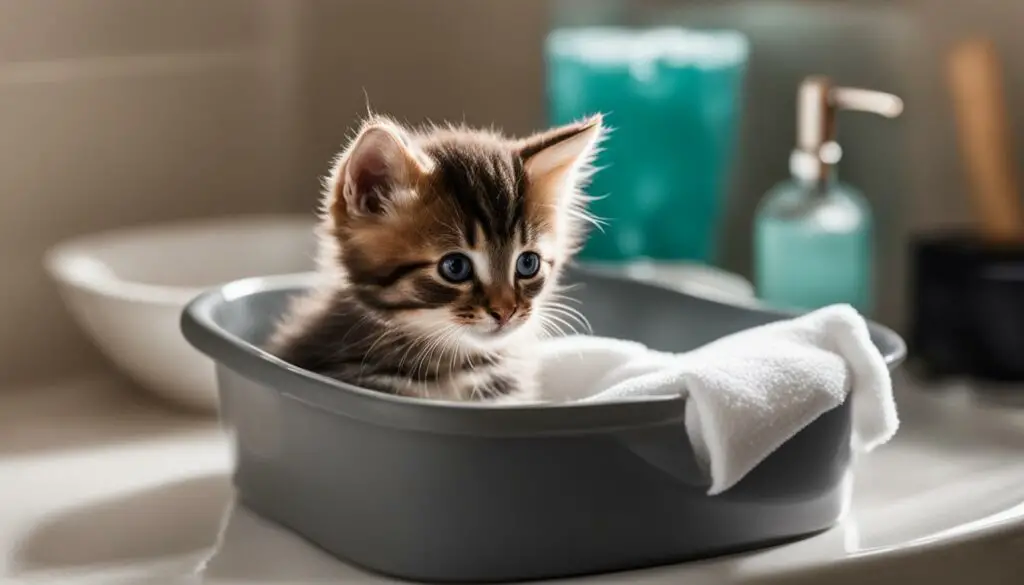
Step 1: Preparation Before The Bath
Before you begin bathing your kitten, it’s important to take some preparatory steps to ensure a smoother and more comfortable experience for both you and your furry friend. These preparations include grooming the kitten, including nail clipping and removing any mats from their coat.
Grooming before bathing is essential as it helps to reduce the risk of scratches during the bath and makes it easier to clean their coat. Start by trimming their nails using a pair of cat nail clippers. Take care to only trim the sharp tip and avoid cutting into the quick, which can cause bleeding. If your kitten has mats in their fur, gently comb them out using a wide-toothed comb or a slicker brush. This will prevent painful tangles and make it easier to thoroughly clean their coat during the bath.
By taking these preparatory steps, you can create a more pleasant and stress-free bathing experience for your kitten.
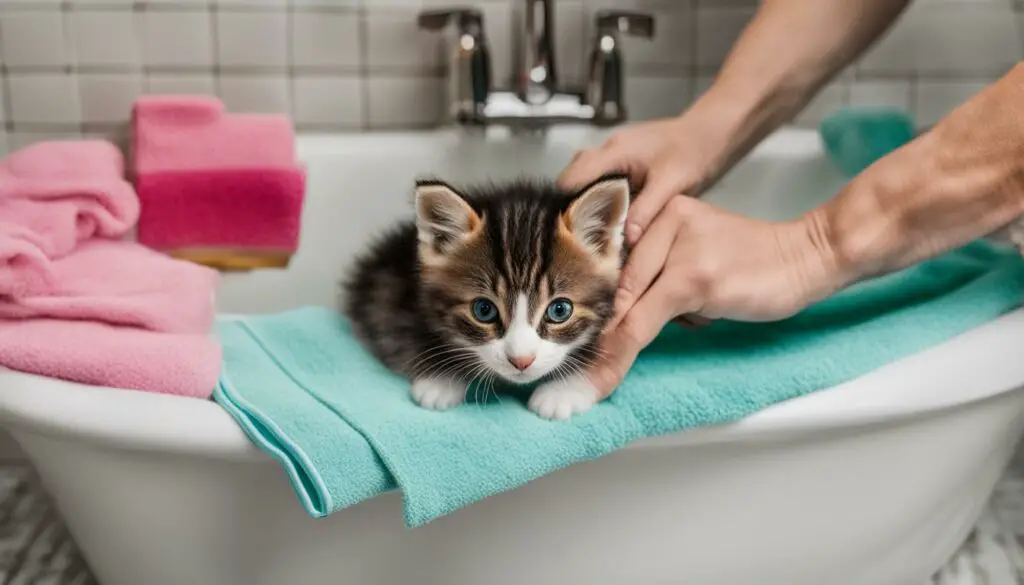
Table: Kitten Grooming Essentials
| Grooming Tools | Description |
|---|---|
| Cat nail clippers | Use these specially designed clippers to safely trim your kitten’s nails and prevent scratches during the bath. |
| Wide-toothed comb or slicker brush | Choose one of these grooming tools to gently remove any mats or tangles from your kitten’s fur before the bath. |
| Grooming wipes | These wipes are useful for cleaning your kitten’s face and paws, especially if they are resistant to a full bath. |
The preparatory steps of grooming your kitten before the bath not only make the bathing process smoother, but they also promote their overall well-being and comfort. By ensuring their nails are trimmed and their coat is free from mats, you can create a more positive and enjoyable bathing experience for both you and your kitten.
Step 2: Introduction To Water
Now that your kitten is settled in the sink and feeling calm, it’s time to gradually introduce them to the water. Remember, this may be their first time experiencing water, so patience and reassurance are key.
Start by turning on the warm water from the back side of the kitten’s body. This allows them to get used to the sound and sensation without feeling overwhelmed. Use a spray nozzle instead of dunking the cat into the water, as this can be a gentler approach.
Keep the spray as close to the kitten’s body as possible and avoid spraying directly on their face, ears, or nose. Cats may need some time to adjust to the feeling of being wet, so go slow and be mindful of their comfort level throughout the process.
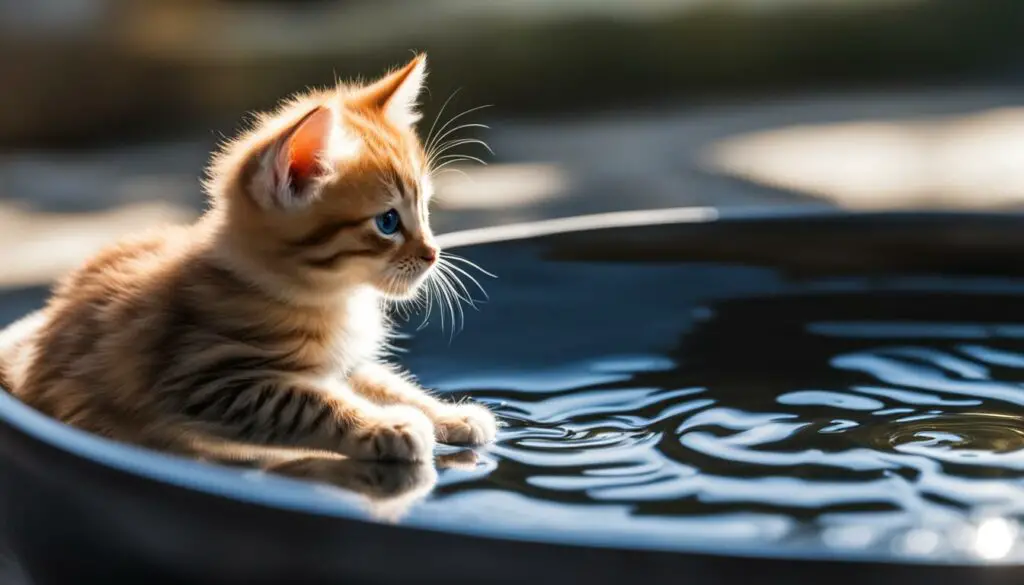
Remember, the introduction to water is just the beginning of the bathing process. Stay tuned for the next steps to ensure a successful and stress-free bathing experience for both you and your kitten.
Step 3: Bathing A Cat
Now that your cat is comfortable with the water temperature and pressure, it’s time to begin the bathing process. Remember, it is important to use a nozzle sprayer instead of dunking your cat into the water. This will help minimize stress and ensure a more enjoyable experience for both you and your feline friend.
Start by wetting your cat’s body, beginning from the tail area. Keep a close eye on your cat’s reaction and proceed to wet the rest of their body and chin, avoiding the sensitive areas such as the eyes, ears, and nose. Keep the spray as close to your cat’s body as possible, ensuring a thorough wash.
Once your cat’s body is wet, it’s time to lather them with cat shampoo or a gentle cat bar. Make sure to properly disperse the shampoo and use your fingertips to massage it into their coat. This will help remove dirt, oils, and any other debris that may have accumulated on their fur.
After lathering, it’s important to rinse off the shampoo thoroughly. Use the nozzle sprayer to gently rinse your cat’s body, ensuring all traces of shampoo are removed. Take your time and make sure there is no residue left on their coat. Finally, gently wring out any excess water from your cat’s fur and wrap them in a warm towel to keep them comfortable.
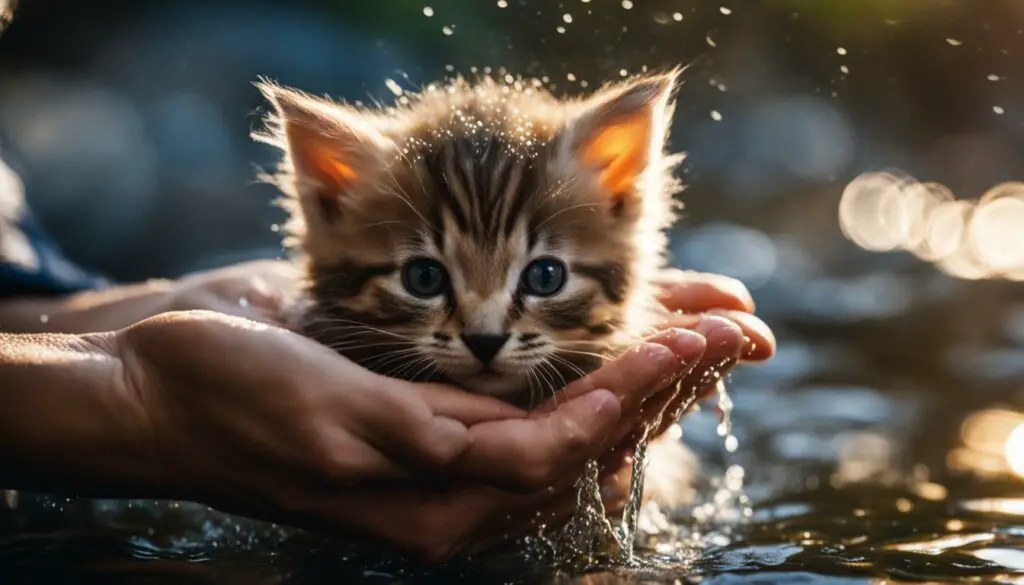
Best Practices for Cat Bathing
While bathing a cat can be challenging, following some best practices can help make the process easier. Here are a few tips to keep in mind:
- Choose a calm and quiet environment for bathing to minimize distractions and stress.
- Use a gentle and cat-specific shampoo or bar that is formulated for their sensitive skin.
- Keep the water temperature warm, but not too hot, to ensure your cat’s comfort.
- Always use a nozzle sprayer instead of dunking your cat into the water to prevent fear or panic.
- Be patient and gentle throughout the bath, providing reassurance and positive reinforcement.
By following these best practices, you can ensure a safe and successful bathing experience for your cat. Remember, regular grooming and maintenance are essential for your cat’s overall health and well-being.
| Benefits of Cat Bathing | Precautions to Take |
|---|---|
| Keeps their coat clean and healthy | Never force a cat into the water |
| Helps remove dirt, oils, and debris | Use cat-specific products only |
| Prevents matting and tangles | Avoid getting water in their ears, eyes, and nose |
| Promotes bonding between you and your cat | Ensure a calm and stress-free environment |
Step 4: Eye And Ear Cleaning
After the bath, it is essential to clean your cat’s eyes and ears to maintain their overall hygiene. Use a damp cotton ball or cloth to gently wipe the area around the eyes, ensuring that you use a fresh cotton ball for each eye to prevent the spread of any potential infections. For the ears, take another clean cotton ball and wipe the outer part of the ears, being careful not to go inside the ear canal as it can cause damage. Remember to be gentle and patient during this process to avoid causing any discomfort to your cat.
To ensure the safety and effectiveness of the cleaning process, it is best to use specialized cat eye wipes and ear cleaning solutions prescribed by a veterinarian. These products are specifically formulated to meet the unique needs of cats and are gentle on their sensitive areas. Avoid using any human products as they may contain ingredients that could be harmful to your feline friend. By using the right products and techniques, you can help keep your cat’s eyes and ears clean and free from potential infections or discomfort.
Cleaning a cat’s eyes:
- Gently wipe the area around the eyes using a damp cotton ball.
- Use a fresh cotton ball for each eye to prevent the spread of infections.
- Be gentle and patient to avoid causing any discomfort to your cat.
Cleaning a cat’s ears:
- Use a clean cotton ball to wipe the outer part of the ears.
- Do not go inside the ear canal to avoid causing damage.
- Use specialized cat ear cleaning solutions prescribed by a veterinarian.
| Cleaning a cat’s eyes | Cleaning a cat’s ears |
|---|---|
| Gently wipe the area around the eyes | Use a clean cotton ball to wipe the outer part of the ears |
| Use a fresh cotton ball for each eye | Do not go inside the ear canal to avoid causing damage |
| Be gentle and patient | Use specialized cat ear cleaning solutions prescribed by a veterinarian |
By incorporating eye and ear cleaning into your cat’s grooming routine, you can help maintain their overall health and prevent any potential issues from developing. Remember to use gentle techniques and the appropriate products to ensure your cat’s comfort and well-being.
Step 5: Drying Process
After the bath, it is important to dry your cat thoroughly to prevent them from catching a cold. Use a warm, large towel to gently rub their body and remove excess water before proceeding with blow drying. Longhaired cats may benefit from additional combing after blow drying to remove tangles and keep their fur in good condition. Proper drying is essential for the comfort and health of your kitten.
To start the drying process, wrap your cat in a towel and gently pat their fur to remove as much moisture as possible. Be sure to use a towel that is soft and absorbent to avoid causing any discomfort to your cat’s skin. Once you have removed most of the water, you can proceed with blow drying.
When using a blow dryer, set it to a low speed and hold it at a safe distance from your cat’s fur to prevent overheating. Keep the dryer moving constantly and avoid concentrating the heat in one spot for too long. This will help to prevent any discomfort or burning sensation for your cat.
If your cat has long hair, consider using a comb or brush to help separate and untangle any knots or mats while blow drying. This will not only ensure that their fur dries evenly, but it will also keep their coat looking neat and well-groomed. Take your time and be gentle, as your cat may be sensitive to any pulling or tugging.
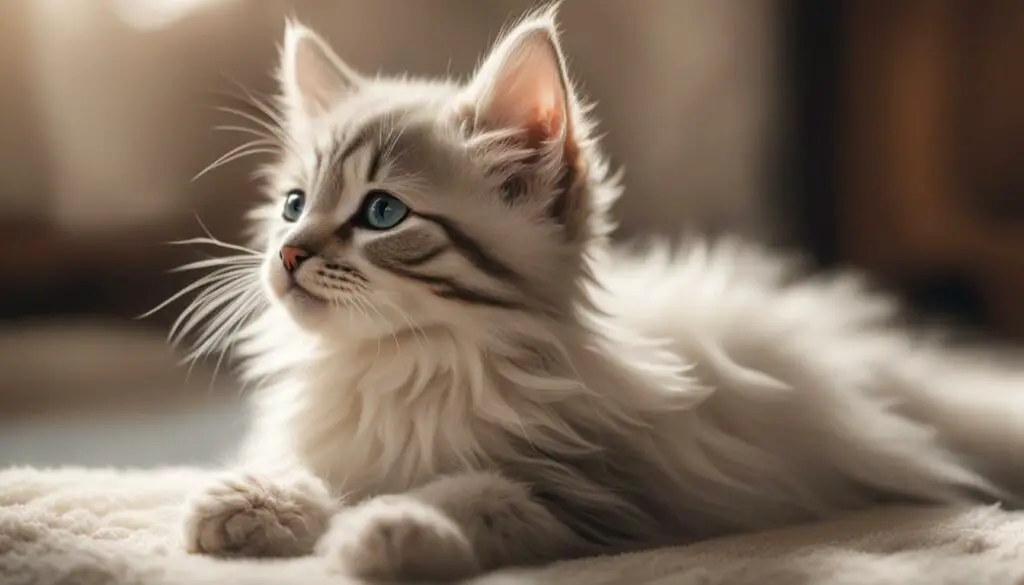
Remember to always monitor your cat’s behavior during the drying process. If they seem uncomfortable or anxious, take a break and give them some time to relax before continuing. The drying process may take some time, especially with longhaired cats, so be patient and allow your cat to air dry naturally if they prefer.
Final Vital Step: Rewards
After a successful bath, it’s crucial to reward your cat for their positive behavior. This not only strengthens the bond between you and your feline friend but also reinforces their good behavior during bath time. Offering a special treat as a high-value delicacy is an excellent way to show your appreciation. Choose a treat that your cat loves and reserve it exclusively for post-bath rewards. This will make it even more enticing and exciting for them.
In addition to treats, providing lots of tender love and care is essential. Take some extra time to cuddle and pet your cat, offering them gentle praise and affectionate words. This positive reinforcement will help your cat associate bath time with pleasant experiences and build a positive attitude towards future baths.
Engaging in playtime after a bath can also be a fantastic reward. If your cat is relaxed and enjoying the experience, introduce their favorite toys and engage in interactive play. This not only helps them burn off some energy but also allows them to release any remaining stress or tension. Playtime after a bath can become a special bonding moment between you and your cat, creating positive associations with the bathing experience.
| Rewards | Description |
|---|---|
| Cat Treats | A special high-value delicacy exclusively reserved for post-bath rewards. |
| Tender Love and Care | Cuddling, petting, and offering gentle praise and affectionate words to show appreciation. |
| Playtime | Engaging in interactive play with your cat using their favorite toys. |
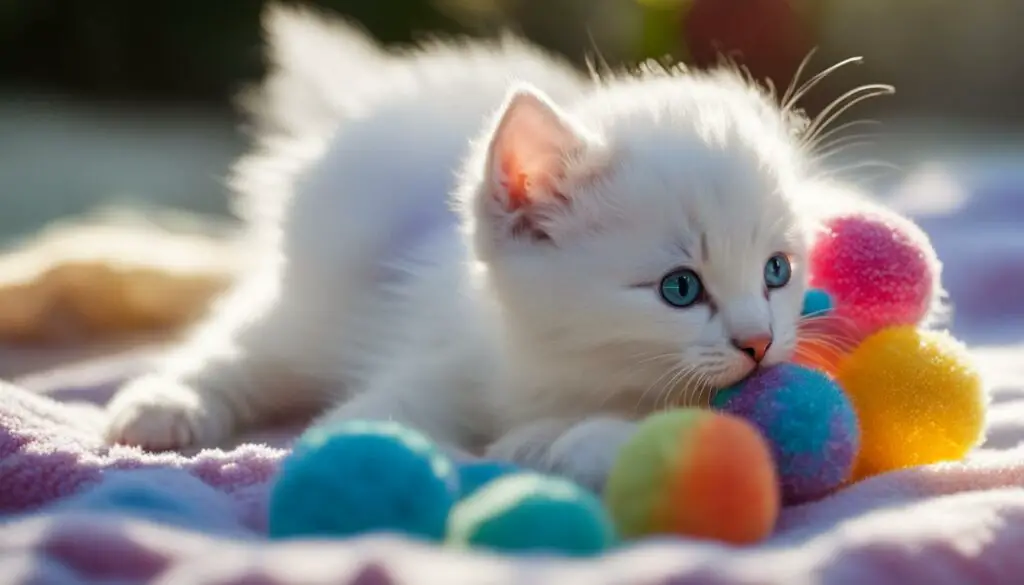
“Rewarding your cat after a bath is an important part of the grooming process. It helps reinforce positive behavior and creates a more enjoyable experience for both you and your feline friend.”
Creating a Positive Bathing Experience
Consistency and positive reinforcement are key to making bathing a stress-free experience for your kitten. By associating rewards with bath time, you can help your cat develop a more positive attitude and reduce any anxiety or fear they may have. Remember to always approach bath time with patience, understanding, and love.
It’s important to note that not all cats may enjoy every aspect of bathing. Some cats may dislike being wet, while others may find the sound of running water intimidating. As a responsible cat owner, it’s essential to respect your cat’s individual preferences and comfort levels. If your cat shows severe distress or aggression during bath time, it may be best to consult with a professional groomer or your veterinarian for guidance on alternative grooming methods.
By following the step-by-step guide provided in this article and rewarding your cat after each bath, you’ll not only keep your cat clean and healthy but also strengthen the bond between you and your furry companion.
Grooming Longhaired and Older Cats: Preventing Hairballs and Matting
Regular grooming is essential for maintaining the health and well-being of longhaired and older cats. These cats require extra attention to prevent hairballs and matting, which can be uncomfortable and potentially harmful to their overall health. By incorporating grooming into their routine, pet owners can help keep their cats comfortable and minimize the risk of such issues.
Grooming Longhaired Cats
Longhaired cats have beautiful coats that require regular brushing to prevent mats and tangles. Start by using a comb or brush specifically designed for long hair, and gently work through the fur, paying close attention to areas prone to matting, such as the belly and behind the ears. Regular brushing not only removes loose hairs but also stimulates the natural oils in the skin, promoting a healthy coat.
Additionally, longhaired cats may benefit from occasional trims to keep their fur at a manageable length. Trimming the fur around the hindquarters and under the tail can help prevent fecal matter from sticking to the fur, reducing the risk of matting and hygiene-related issues. Consult with a professional cat groomer if you are unsure about how to properly trim your cat’s fur.
Grooming Older Cats
As cats age, their grooming abilities may decline. Older cats may have difficulty reaching certain areas of their bodies to groom themselves effectively, leading to matting and hygiene problems. Regular brushing can help remove loose fur and prevent matting in older cats. Be gentle and patient with your senior cat, providing them with a comfortable and calm environment during grooming sessions.
In addition to brushing, older cats may require assistance with nail trimming and dental care. Overgrown nails can be uncomfortable and potentially cause issues with mobility, while dental problems can lead to pain and difficulty eating. Consult with your veterinarian for guidance on how to safely trim your cat’s nails and maintain their dental health.
Preventing Hairballs and Matting
Preventing hairballs and matting in cats requires a combination of regular grooming and a balanced diet. Incorporate high-quality cat food into your cat’s diet, as it can help promote healthy digestion and reduce the formation of hairballs. Additionally, providing your cat with plenty of fresh water and encouraging exercise can aid in the natural elimination of hairballs.
When grooming your cat, pay close attention to areas prone to matting, such as behind the ears, under the armpits, and on the belly. Use a brush or comb to gently remove any tangles or mats that may have formed. If the matting is severe or difficult to remove, consult with a professional cat groomer to prevent causing any discomfort or injury to your cat.
Grooming longhaired and older cats requires time, patience, and gentle handling. By incorporating regular grooming into your cat’s routine, you can help prevent hairballs, reduce the risk of matting, and ensure their overall comfort and well-being.
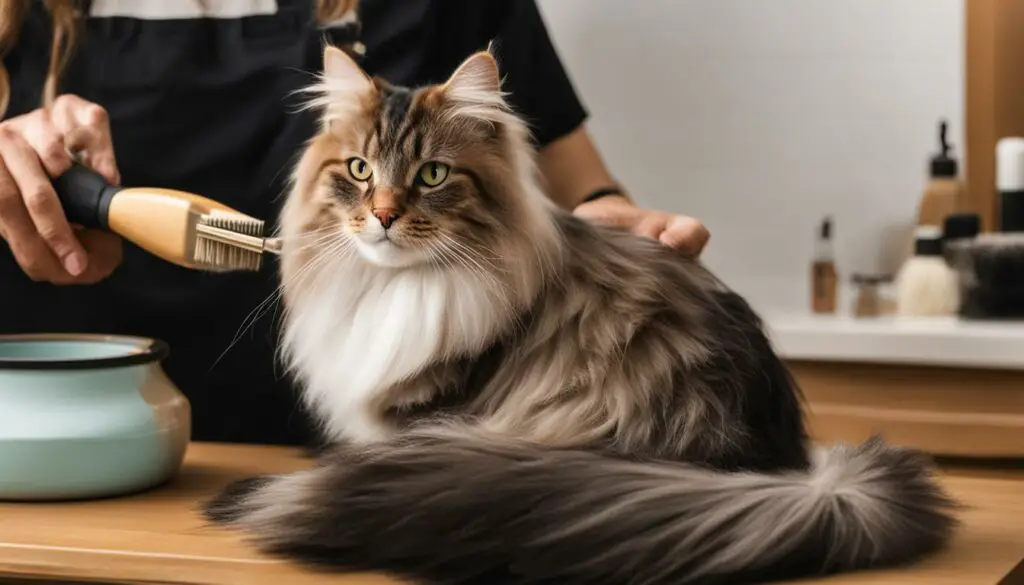
Avoiding Common Mistakes in Cat Grooming
When it comes to grooming cats, it’s important to be aware of common mistakes that can occur. These mistakes can lead to grooming aggression in cats, inefficient grooming techniques, and a negative experience for both the cat and the groomer. By being mindful and educated about proper grooming techniques, you can avoid these common pitfalls.
Mistake 1: Skipping the Temperament and Needs Assessment
One common mistake in cat grooming is skipping the assessment of a cat’s temperament and needs before starting the grooming process. It’s crucial to understand a cat’s individual personality and any specific sensitivities or triggers they may have. This allows you to tailor the grooming experience to their needs and minimize stress or aggression during the process.
Mistake 2: Working Too Slowly
Another mistake is working too slowly and exceeding the cat’s time frame for a complete groom. Cats have limited patience and attention spans, so it’s important to work efficiently and effectively. This means having all the necessary grooming tools and products prepared in advance, working in a calm and focused manner, and minimizing unnecessary delays or distractions.
Mistake 3: Inefficient Grooming Techniques
Using inefficient grooming techniques can also lead to problems during the grooming process. For example, not properly degreasing a cat’s fur during the bath can result in a coat that remains greasy and prone to matting. It’s important to use the right grooming products, follow the proper steps, and ensure thorough cleaning and drying to maintain the cat’s overall hygiene and prevent future grooming issues.
Mistake 4: Neglecting the Well-being of the Cat
Finally, neglecting the well-being of the cat during the grooming process can also be a significant mistake. It’s essential to prioritize the cat’s comfort, safety, and emotional well-being throughout the grooming session. This includes providing breaks when needed, using gentle handling techniques, and monitoring the cat’s behavior and stress levels to ensure they are not overwhelmed or distressed.
| Common Mistakes in Cat Grooming |
|---|
| Skipping the temperament and needs assessment |
| Working too slowly |
| Inefficient grooming techniques |
| Neglecting the well-being of the cat |
By avoiding these common mistakes and adopting proper grooming techniques, you can ensure a positive grooming experience for your cat and maintain their overall health and well-being. Remember to always approach grooming with patience, understanding, and a focus on the individual needs of your cat. A stress-free grooming routine will not only keep your cat looking their best but also strengthen the bond between you and your feline friend.
Caring for Kittens from Birth to Eight Weeks
When it comes to caring for kittens, the first eight weeks are crucial for their health and well-being. During this period, you play a vital role in ensuring their needs are met and setting them up for a happy and healthy life. Here is a comprehensive guide to help you navigate the care of kittens from birth to eight weeks.
Hygiene and Health Care:
Proper hygiene and health care are essential for young kittens. Keep their nesting area clean and sanitized, providing a warm and comfortable environment. Regularly check their eyes, ears, and bottom for any signs of infection or issues. Clean their eyes with a damp, warm cloth and gently wipe their ears with a specialized kitten ear cleaning solution.
Nutrition and Feeding:
Kittens should be fed a diet specifically formulated for their nutritional needs. Choose high-quality kitten food that provides the necessary nutrients for growth and development. Offer them small, frequent meals throughout the day to ensure they are adequately nourished. Gradually introduce solid food around four weeks of age, starting with wet food and eventually transitioning to a balanced kitten diet.
Socialization and Playtime:
During the first eight weeks, kittens are highly impressionable and learn valuable social skills. Provide plenty of opportunities for interaction and playtime. Handle them gently and expose them to different sights, sounds, and experiences. This will help them develop confidence and adaptability, making them well-adjusted adult cats.
| Week | Key Milestones |
|---|---|
| 1-2 | Opening their eyes, crawling, and starting to explore |
| 3-4 | Development of coordination, playing with littermates |
| 5-6 | Beginning to eat solid food, social interactions with humans |
| 7-8 | Full weaning, improved coordination and motor skills |
Remember, each kitten is unique, and their development may vary slightly. It’s important to consult with a veterinarian for personalized guidance and advice. By providing proper care, nutrition, and socialization, you are giving your kittens the best start in life.
Conclusion: Mastering the Art of Bathing Kittens
In conclusion, learning how to bathe kittens safely and effectively is an important skill for every cat owner. By following the step-by-step guide provided in this article, you can ensure a stress-free bathing experience for both you and your furry friend.
Remember, most cats do not need regular baths unless they have a medical issue or get soiled. However, longhaired cats can benefit from routine bathing to prevent matting and maintain a clean coat. Proper grooming, including bathing, helps to promote the overall health and well-being of cats.
When preparing for a bath, choose a suitable location such as a deep sink and gather all necessary bathing equipment. Take the time to prepare your kitten by trimming their nails and brushing out any mats beforehand. Introduce the water gradually and use a spray nozzle to wet their body, lather with shampoo, and rinse thoroughly. After the bath, gently dry your kitten with a warm towel and reward them for their positive behavior.
Consistent grooming is particularly important for longhaired and older cats, as it helps prevent hairballs, mats, and pelts. Regular grooming every four to six weeks can make a significant difference in their coat’s condition. However, it’s essential to avoid common mistakes in cat grooming, such as skipping the temperament assessment and working too slowly.
In conclusion, by mastering the art of bathing kittens and understanding the importance of proper grooming, you can provide your feline companion with the care they need to stay clean, healthy, and happy.
FAQ
Do all cats need baths?
No, most cats, especially shorthaired ones, do not need regular baths unless they have a medical issue or get soiled. Longhaired cats benefit from routine bathing to degrease their coat and prevent matting.
How often should I bathe my kitten?
Bathing should only be done when necessary. For longhaired cats, routine bathing every four to six weeks can help maintain their coat’s cleanliness and prevent matting.
What location is best for bathing a kitten?
A deep waist-high sink in the kitchen or bathroom is a good choice as it provides an enclosed space with enough room and easy handling. Avoid using a bathtub as it is too large and easy for the kitten to escape.
What equipment do I need for bathing my kitten?
You will need gloves, cat shampoo or Chubbs Bar, towels for drying, ear and eye cleaning solutions, and a pet shower sprayer kit with a stainless steel hose for regular bathing.
Should I trim my kitten’s nails before bathing?
Yes, it is recommended to clip the kitten’s nails before bathing to reduce the risk of scratches.
How do I introduce my kitten to water for the first time?
Place the kitten slowly into the sink and start the warm water from the back side of their body to allow them to get used to the sound and sensation. Use a spray nozzle instead of dunking the cat into water.
How do I lather the cat with shampoo?
Wet the cat’s body and chin, avoiding the eyes, ears, and nose. Lather the cat with shampoo or a bar, ensuring proper dispersion and cleansing. Use fingertips to massage the shampoo into the coat.
How do I dry my cat after bathing?
Use a warm towel to gently rub their body and remove excess water. Then, use a professional blow dryer on low speed to dry the cat’s fur. Longhaired cats may benefit from additional combing to remove tangles.
How often should I clean my cat’s eyes and ears?
It is recommended to clean your cat’s eyes and ears regularly. Use a damp cotton ball or cloth to wipe their eyes and clean the outer part of their ears with a cotton ball. Avoid going inside the ear canal.
What should I do after a successful bath to reward my cat?
Offer your cat a special treat and provide lots of love and care. Engage in playtime if your cat is relaxed and enjoying the experience. By associating positive rewards with bathing, you can help your cat develop a more positive attitude towards future baths.
Do longhaired and older cats require regular grooming?
Yes, regular grooming, including bathing and blow drying, is especially important for longhaired and older cats. It helps prevent hairballs, mats, and pelts in their fur. Neglected snags can turn into mats, so it’s crucial for pet owners to assist in the grooming process every four to six weeks.
What are common mistakes to avoid in cat grooming?
Some common mistakes to avoid include skipping the temperament and needs assessment before grooming a cat, working too slowly and exceeding the cat’s time frame for a complete groom, and not degreasing a cat properly during the bath. These mistakes can lead to a negative grooming experience for both the cat and the groomer.
What should I do to care for kittens from birth to eight weeks?
Provide a warm environment, proper feeding, regular cleaning, and socialization opportunities. These are essential components of kitten care during this crucial developmental stage. Adequate care and attention during this time will contribute to the future health and happiness of your kitten.

